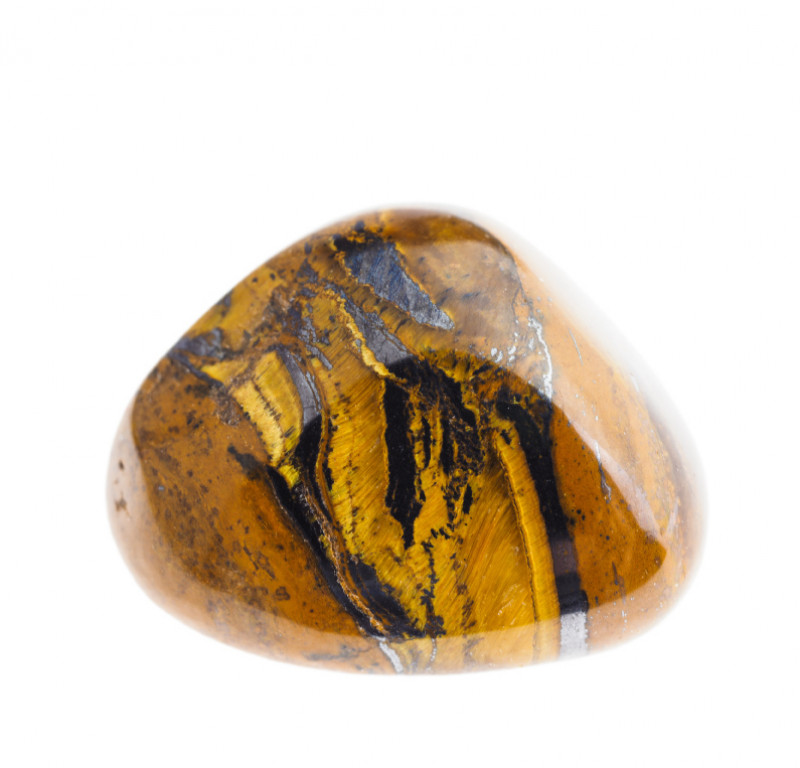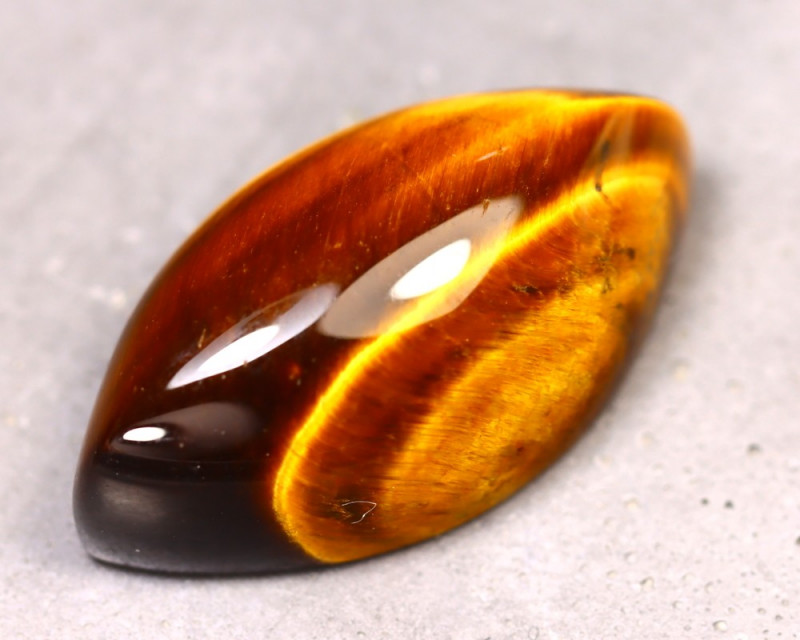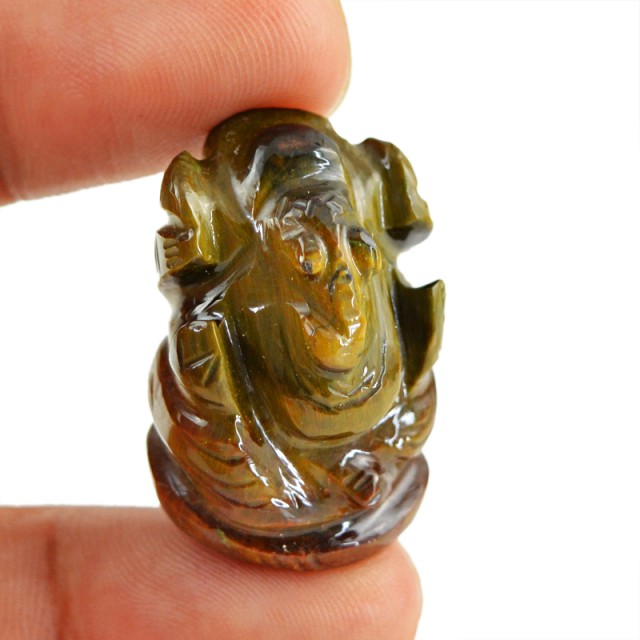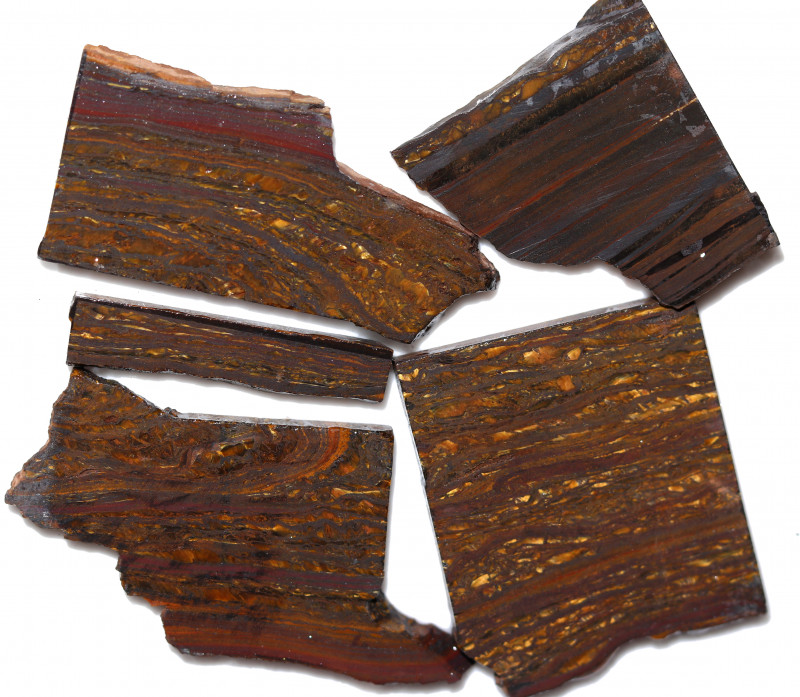
Tiger's Eye Stone: Benefits, Meanings & Properties
 When you gaze into a tiger's eye stone, your inner tiger gazes back at you. Tiger's eye is a unique type of chalcedony that’s amber to brown in color with grayish-black stripes across its surface.
When you gaze into a tiger's eye stone, your inner tiger gazes back at you. Tiger's eye is a unique type of chalcedony that’s amber to brown in color with grayish-black stripes across its surface.
Tiger's eye’s woodsy tones make it a popular stone for feminine and masculine accessories. A tiger's eye necklace or tiger's eye cufflinks can help anyone show off their taste and remind them to embrace their confidence!
First, let’s raise your confidence about the tiger's eye stone itself. In this guide, we’ll break down tiger eye’s mineral characteristics, spiritual properties, value, and more!

About Tiger's Eye Stone
Tiger's eye is a metamorphic rock used as a semi-precious gemstone for its mesmerizing bands in shades of orange, yellow, gray, and black. As a durable stone, tiger's eye is a great gem for everyday wear, but it’s especially lucky for the zodiac signs Capricorn and Gemini.
As a zodiac stone for Capricorn, tiger's eye helps these disciplinaries hone in their focus and manifest success. For our twin-sign Geminis, tiger eye stone can balance their extremes and revitalize their precious relationships.
If you’re a Gemini born in June, you have double luck because tiger eye is also your spiritual birthstone. If pearl or alexandrite don’t bring out enough fire for you, tiger's eye’s blazing shades and fierce traits certainly will!
Are you celebrating a 9th or 18th anniversary soon? Tiger's eye is the anniversary stone for you! Every year together brings new surprises, so why not spice things up with a vibrant tiger's eye bracelet to commemorate the occasion?
Mineral Characteristics
Tiger's eye is a type of chalcedony rock that displays simple chatoyancy, which differs from “cat’s eye” chatoyancy.
But wait: what’s chatoyancy and why is it important?
Well, the fibers in stones with simple chatoyancy are not organized and focused enough to create one band of light, like a cat’s eye. Instead, simple chatoyancy in tiger's eye displays multiple streaks of light. Other stones with simple chatoyancy include charoite, pietersite, and seraphinite.
The most similar gemstone to tiger's eye is hawk's eye. What differentiates these two? Hawk’s eye differs in its blue coloring, but both gems form through the same process — for buyers, this means you have multiple color options!
Tiger's eye is different from other types of quartz because it technically starts a quartz pseudomorph.
Simply put, pseudomorphs like tiger's eye start as one mineral before changing into another. In fact, one synonym of tiger's eye is “pseudocrocidolite,” as it begins as a crocidolite mineral.
What else can we learn about the tiger’s eye’s mineral characteristics?

Tiger's Eye Specifications and Characteristics
Mohs hardness: 6.5-7
Color: Golden brown, reddish-brown, golden-yellow, bronze, brown; Usually color-banded
Crystal structure: Hexagonal (trigonal)
Luster: Vitreous (glass-like) or silky
Transparency: Semi-translucent to opaque
Refractive index: 1.544-1.553
Density: 2.55-2.91
Cleavage: None
Fracture: Conchoidal or splintery
Streak: Yellowish-brown
Luminescence: None
Pleochroism: None
Birefringence: 0.009
Dispersion: 0.013 (weak to unobservable)
Optical phenomena: Simple chatoyancy
Tiger eye stone has some interesting qualities, but what does the stone mean?

Tiger Eye Stone Meaning
Tiger's eye is named for its resemblance to, well, a tiger’s eye! However, the gem’s name didn’t start as “tiger's eye.” When the stone was first scientifically described in 1811, German chemist Martin Heinrich Klaproth called it “blue ironstone.”
The name “tiger's eye” came from J.F. Hausmann in 1831, “on account of its nap-like appearance.” Because the stone’s first source was Cape Colony in Africa, it’s sometimes called “South African cat’s eye.”
Outside of Africa, different cultures attribute unique symbolism to tiger's eye.
In China, tiger's eye symbolizes the intense focus and clear sight of a tiger. Tigers are one of the 12 animals of the Chinese zodiac. Those born in the year of the tiger are represented by the animal’s “power and lordliness.”
Furthermore, the four celestial creatures of Chinese Feng Shui include the turtle, dragon, phoenix, and of course, the tiger. Tiger's eye stones used in Feng Shui represent wisdom, strength, and good luck.
Similarly in spiritual circles, tiger eye stone symbolizes inner fortitude, focus, and self-confidence. Moreover, the tiger's role as “king” signifies protection from evil.
Many Middle Eastern and Asian cultures seek protection from the “evil eye,” a curse-bearing glance that brings bad luck or harm to the person receiving it.
Believers protect themselves in a few ways, often with a physical evil-eye talisman. Tiger's eye is another protective measure taken to repel the evil eye’s gaze.
For more ways to use the stone, let’s get into the myriad of tiger eye stone benefits.

Tiger's Eye Healing Properties
Tiger's eye stones provide uplifting and strengthening energies to anyone who uses them as a healing crystal.
Tiger's eye stone properties for physical healing include regulating the circulatory system, soothing abdominal pain, and strengthening bones. Some say that a tiger's eye can ease eye pain and help heal broken bones as well.
Keeping steady motivation can be a struggle. Sometimes, that new episode of your favorite show just seems way more appealing than work, right? Well, tiger's eye can give you the push you need to get ahead!
With a tiger eye stone, you’ll streamline your focus to view problems with wisdom and clarity. Throw in the stone’s lucky properties? Now you’ve got a recipe for success!
What if a lack of motivation comes from emotional turmoil? If you’re suffering from imposter syndrome or mood swings, tiger's eye can help. Emotional stability, self-confidence, and stress reduction are some of the best tiger's eye stone effects.
Tiger's eye stone reminds you that you have what it takes if you dare to believe in yourself.
What Chakra is Tiger’s Eye?
Chakra work is a favorite among spiritual healers, as chakras are natural healing centers in the body. As a chakra stone, tiger's eye opens our second energy center, the sacral chakra.
The Sanskrit word for the sacral chakra translates to “where the self is established.” Indeed, the sacral chakra is where we establish our identity through creativity, self-worth, and emotional expression.
When the sacral chakra is blocked, we may feel lethargic, unstable, or overwhelmed. Tiger's eye can open the chakra, allowing us to articulate our emotions, connect with others, and feel confident in our abilities.
We’ve covered the geological and holistic properties of this dynamic gemstone. So, what factors should you consider when buying tiger's eye?

Tiger's Eye Gemstone Properties
If you’re new to buying gemstones, you should know that every gemstone has a few buying factors that determine its value. Once you know the buying factors (gemstone properties), you’re equipped to make informed purchases.
When it comes to buying tiger's eye stones, the key factors are the stone’s cut, color, and treatments.
Cut
The cut used on a tiger's eye stone is typically chosen to accentuate the stone’s chatoyancy. Most often, cabochons and beads display the reflective “tiger's eye” best.
Cabochons are often associated with decorative items or palm stones, but tiger's eye cabochons are incredibly versatile. Cufflinks, necklaces, and earrings can all have tiger's eye cabochons at their center.
Tumbled stones are another popular cut. Carvings can also be employed with tiger's eye, and skilled carvers have created intricate floral designs and figurines.
Color
Tiger's eye is known for its sweet golden-brown color that goes from light to dark and back as you follow along with its stacked layers. Often, the darkest layers will look black.
The stone’s color can shift when seen from varying angles. Due to the signature chatoyancy, turning the stone under the light allows you to see different shades at different angles.
Treatments
The most common tiger's eye treatments include bleaching, heat, and dyeing.
If a tiger's eye is too dark to sell, it may go through a “bleaching” enhancement. No bleach is involved, but the result is similar. During the actual treatment, nitric acid lightens the stone enough to create a more attractive color.
While natural tiger's eye stones show red tints, red tiger's eye is often developed artificially. Heat applied to a golden tiger's eye stone transforms the color into a striking red, sometimes traded as “Bull’s eye.”
The dyeing process might be employed on tiger's eye gems to make the color more saturated or change the color altogether.
On the topic of change, tiger's eye has gone through a long, transformative journey to become what it is today.

Tiger's Eye History
Tiger's eye was first recorded by French ornithologist Francois Levaillant in 1784, although Levaillant didn’t officially identify the stone.
In 1803, the German naturalist Martin Hinrich Lichtenstein discovered tiger's eye in Africa. It wasn’t until 1811 that German chemist Martin Heinrich Klaproth gave tiger's eye official scientific recognition.
While tiger's eye’s place in modern literature started in the 18th century, its place in history goes back a few more centuries.
In ancient Rome, tiger's eye was thought to bring courage. Roman soldiers would often carry engraved tiger's eye stones with them to ensure endurance and protection.
Ancient Egyptians connected tiger's eye to their sun god, Ra. They believed tiger's eye harnessed the god’s vision and vitality. Egyptians would often use tiger's eye stones on their statues’ eyes to feel Ra’s protection.
Pharaohs and other rulers wore tiger's eye jewelry for clarity and strength. Tiger's eye was also put into pharaohs' tombs as a tool to peacefully guide them to the afterlife.
As we’ve mentioned, this warm-hued stone holds a significant place in Chinese culture. Tigers are prominent in Chinese art and architecture, often shown with the Chinese character for “king” marked in the animal’s fur.
Throughout Chinese myths, the tiger is a benevolent king, guarding his kingdom against harmful forces. Therefore, carved tiger's eye talismans and amulets are often used for protection.
In fact, China is one of many countries sourcing the stone. Where else does tiger’s eye come from?

Tiger's Eye Stone Formation and Sources
Tiger's eye forms when crocidolite fibers get replaced by silica, transforming the stone into quartz. Iron is present during the formation, and the amount of iron oxidized inside the stone can determine its color.
With minimal iron, the stone is blue and referred to as hawk’s eye. When more iron is present, the stone becomes golden brown, creating tiger's eye. Sometimes, the final stone can be both blue and golden brown.
So where can we find these gorgeous tiger's eye gems?
Mining Locations
The most common place to find tiger's eye is in South Africa, but Australia, Thailand, and the U.S. boast impressive deposits, too.
In the U.S., tiger's eye is mined out of Arizona and Montana. Additionally, the stone comes from the following countries:
Brazil
India
Burma/Myanmar
Namibia
United Kingdom
China
Once the stone is unearthed, it’s sorted, polished and cut, and finally, brought to the market. So, is tiger's eye stone expensive?

Tiger's Eye Prices and Value
Although tiger's eye is only produced in a few places, the stone is relatively common. The average tiger's eye stone price is very affordable.
Most tiger's eye gems are $0.10-$1.00 per carat. Specimens that show good chatoyancy or rich coloring can be between $1-$3 per carat.
Tiger's eye stones with exceedingly high quality or rare coloring, like blue and golden-brown specimens, can command much higher prices. Museum-grade tiger's eye may cost upwards of $400.
Lastly, you’ll need to know how to clean tiger's eye stone to ensure your gem lasts as long as possible.
Tiger's Eye Care and Maintenance
Tiger's eye stones have great wearability, but it’s best to avoid wearing the stone during vigorous activities. You should also avoid your tiger's eye (particularly if it's been treated) coming into contact with:
Household chemicals like ammonia, bleach, or any acidic solutions
Aerosol sprays or perfumes (e.g. hairspray, body mist, etc)
Harder stones (e.g. topaz, beryl stones, corundum stones, diamonds)
To clean your tiger's eye, a basic warm water and soap solution will do the trick. If the stone has any stubborn dirt or grime remaining, dip a soft brush into the solution and gently scrub the gem’s surface. Voila! You have a tiger's eye stone that’s good as new!

Ready to Buy Tiger Eye Stones?
Everyone can agree that tigers show unparalleled strength and ferocity. Tiger's eye stones, while brilliant and beautiful, possess strength and ferocity of their own!
With a tiger's eye in hand, you’ll discover the strength within. It may feel safe to stay on the sidelines, but success comes to those who break out of the pack and hunt for it!
Take it from pop icon Madonna: “Better to live one year as a tiger, than a hundred as a sheep.”
Search the Gemstone Encyclopedia
Related Auctions
Related Articles
Originally the Birthstones or gemstones were associated with a zodiac sign or the month of a individuals birth. Find out what your stone is and view the stones we have for sale
8th Feb 2021
There are dozens of quartz and chalcedony gems with various colors and patterns. Learn all about quartz properties and every type of quartz, from amethyst and agate to plasma and phantom quartz!
15th Oct 2020
Hackmanite is a pink to violet sodalite gem known for its unique color-change and luminescence. Learn why hackmanite is special, from its rare qualities to the types of hackmanite jewelry available.
28th Mar 2018
Latest Articles
Simpsonite is a lesser-known mineral known on the gem market for its durability, yellow-orange color, and rarity. Discover all the properties, uses, prices, and history of simpsonite.
3rd Mar 2025
Kurnakovite is a colorless crystal related to inderite and rarely faceted but known among collectors. Explore the mineral traits, history, prices, and more in this kurnakovite guide.
17th Feb 2025
Prosopite is an uncommon gemstone known for its rare robin’s egg blue form used for cabochons. Discover the history, benefits, prices, and powers of prosopite gemstones!
3rd Feb 2025
Article Categories
How To's is where you will find helpful articles from gem Rock Auctions on how to cut gemstones, select gemstones and buy gemstones.
9 Articles





